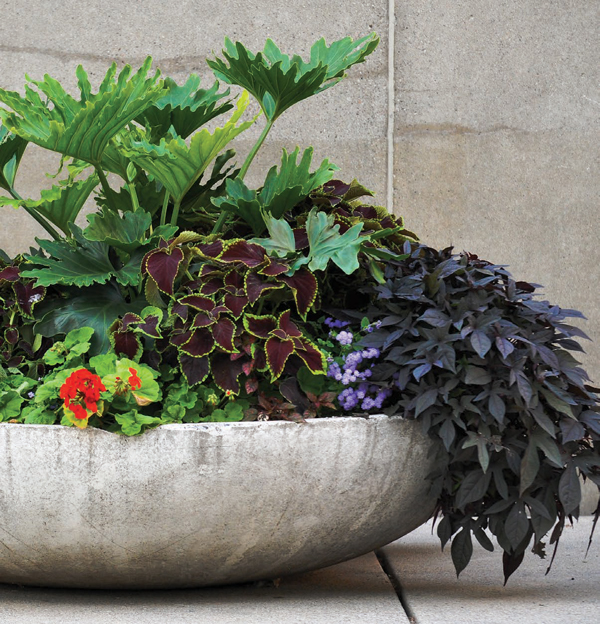
Colorful blooms greet people on your front step. Elaborate arrangements of succulents decorate either end of your sunny deck. Tomatoes, peppers and cilantro entice you to make homemade salsa. And window boxes invite you to clip fresh herbs. Container gardening is an excellent option for both seasonal outdoor decor and edible plants.
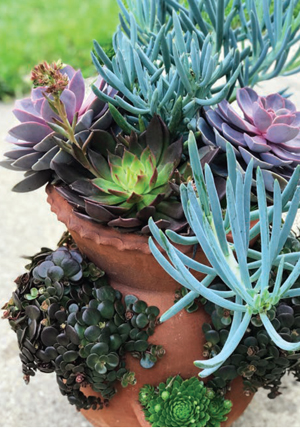 There are some great benefits to container gardening that make it an excellent option for both casual and die-hard gardeners. If you are short on space, containers allow you to enjoy all the benefits of a full garden even if all you have to work with is a patio, porch or driveway. You can grow distinctly different plants in separate containers right next to each other, allowing you to tailor the soil, fertilizer and other care to each plant.
There are some great benefits to container gardening that make it an excellent option for both casual and die-hard gardeners. If you are short on space, containers allow you to enjoy all the benefits of a full garden even if all you have to work with is a patio, porch or driveway. You can grow distinctly different plants in separate containers right next to each other, allowing you to tailor the soil, fertilizer and other care to each plant.
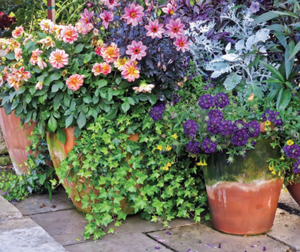 You can rotate plants in and out based on the seasons or your whims so you always have a fresh display to enjoy. Weeds—and therefore weeding— are kept to a minimum, making containers easy to care for. And you can manage the soil far more easily than larger spaces in the open garden, which allows you to give your plants exactly what they need to be their best.
You can rotate plants in and out based on the seasons or your whims so you always have a fresh display to enjoy. Weeds—and therefore weeding— are kept to a minimum, making containers easy to care for. And you can manage the soil far more easily than larger spaces in the open garden, which allows you to give your plants exactly what they need to be their best.
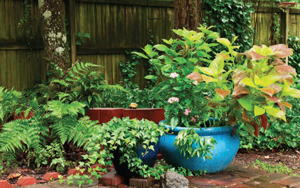 Choosing containers
Choosing containers
The larger the container, the more you can plant, which actually results in less day-to-day work since the higher volume of soil will retain more water and require less frequent watering. But there are other factors that you should consider.
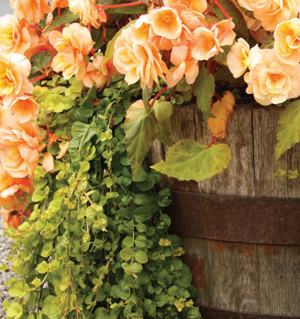 Placement should inform size. Half-barrels and metal wash tubs are large and great for ends of driveways or as decor in a back yard. Taller planters on a stand make a decorative statement on porches or on either side of front doors. An arrangement of smaller terra cotta pots adds European charm to any small patio.
Placement should inform size. Half-barrels and metal wash tubs are large and great for ends of driveways or as decor in a back yard. Taller planters on a stand make a decorative statement on porches or on either side of front doors. An arrangement of smaller terra cotta pots adds European charm to any small patio.
Another thing to ask yourself is how frequently you will be able to water your planters. Containers will dry out faster than raised beds or an open garden, so if you are unable to water every day or every other day, consider self-watering containers. These are usually made of synthetic materials, such as plastic, with an internal system that holds the soil above a reservoir of water at the bottom. This encourages roots to grow down deep into the water and allows you to pre-fill the planter with water to last a few days. It’s a life-saver in summer, and a time-saver anytime.
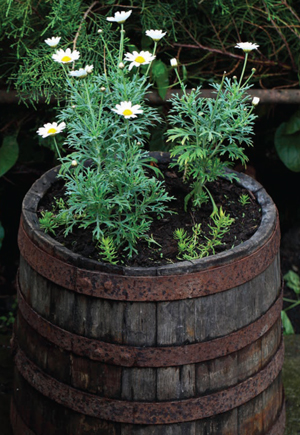 You should also consider materials carefully. You may like the look of natural wood whisky half-barrels, but the wood will eventually break down, especially if placed on the ground. Natural materials, such as wood or terra cotta, will dry out faster than plastic, requiring more waterings. Terra cotta and ceramic, while beautiful and charming, are also breakable, so position them in areas where they won’t be in harm’s way, or look to buy plastic or foam versions that offer the look without the potential for damage. Dark-colored planters set in direct sunlight will heat up more during the day and dry out even faster, and possibly lead to damaged roots. Hanging planters are probably the most labor intensive, requiring multiple waterings a day in some climates. Metal is sleek and modern, but will heat up significantly and potentially lead to damaged roots.
You should also consider materials carefully. You may like the look of natural wood whisky half-barrels, but the wood will eventually break down, especially if placed on the ground. Natural materials, such as wood or terra cotta, will dry out faster than plastic, requiring more waterings. Terra cotta and ceramic, while beautiful and charming, are also breakable, so position them in areas where they won’t be in harm’s way, or look to buy plastic or foam versions that offer the look without the potential for damage. Dark-colored planters set in direct sunlight will heat up more during the day and dry out even faster, and possibly lead to damaged roots. Hanging planters are probably the most labor intensive, requiring multiple waterings a day in some climates. Metal is sleek and modern, but will heat up significantly and potentially lead to damaged roots.
 Planters can become significantly heavier with soil, water and plants added, so also consider whether the container will need to be moved, and whether a patio or deck can support the weight. Position containers where you plan to keep them before you fill with dirt, plants and water. Or, purchase plant caddies with wheels that allow you to move the containers around.
Planters can become significantly heavier with soil, water and plants added, so also consider whether the container will need to be moved, and whether a patio or deck can support the weight. Position containers where you plan to keep them before you fill with dirt, plants and water. Or, purchase plant caddies with wheels that allow you to move the containers around.
Regardless of size or materials, all containers need some kind of drainage holes to prevent roots from getting waterlogged or rotting.
Weigh the pros and cons of each style, think through where you plan to place them, and choose accordingly. Be sure that wherever you plan to position them has easy access to water and the appropriate amount of light for your particular plants.
Plant for success
The easiest way to populate your containers is with a visit to the local gardening center to see what flowers and vegetables are available and in season. As with all plants, read the accompanying description tabs carefully so you know what the plant needs, paying special attention to the level of sunlight required so you can ensure that planters and containers are situated to receive the appropriate amount of sun. The tabs should also tell you which plants will thrive in containers.
One thing you’ll consider is whether a plant is a perennial or an annual. Perennials are plants that, once established, will grow, die back and then regrow every season. Flowering perennials will bloom for a specific time period and then wither, only to return the same time next year. They are a great investment when establishing a garden bed in your yard since they will give color the same time year after year.
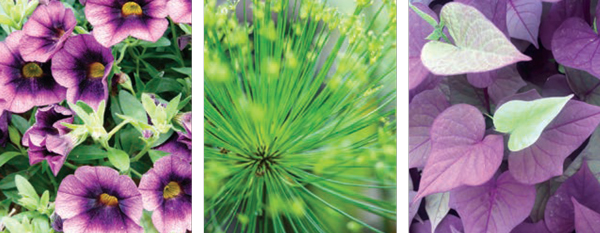
WHEN PLANTING A DECORATIVE CONTAINER, THINK ABOUT THE VISUAL DESIGN OF THE MINI-GARDEN YOU WANT TO ACHIEVE. ONE TACTIC FOR PLANTING A DECORATIVE FLORAL CONTAINER IS THE “THRILLER, FILLER, SPILLER” METHOD.
If you have large enough containers, such as whiskey barrels or large cement planters, you might want to invest in perennials like daisies and watch them come back year after year, or choose decorative shrubbery that can overwinter. On the other hand, since one of the benefits of containers is the option of swapping out plants based on season, you might want to stick with annuals. Annuals have a shorter life span, but they give you all they’ve got when it comes to color, blooming throughout a season until they run their course and die back. Another option is to maintain a perennial like a decorative shrub for year-round container interest, and plant different annuals around it as the season dictates.
When planting a decorative container, think about the visual design of the mini-garden you want to achieve. One tactic for planting a decorative floral container is the “thriller, filler, spiller” method. Choose a vertical “thrilling” plant to dominate the center of the container, such as an ornamental grass. Choose smaller “filler” plants to surround the main focal point with bright color, like petunias. Then, add a few “spillers” that cascade down, such as ivy.
Another popular design theme is to go monochromatic, or shades of the same color. You can choose a selection of all greenery, or go with multiple flowering plants in different shades of reds, purples or whites. You can even plan a succulent garden in various shades of green.
An edible garden
If you are building a container of edible plants— such as tomatoes, peppers, or herbs—you will need to choose specific varieties suitable for containers. For example, with tomatoes, you will want to choose “patio” varieties, which are literally suited for growing in containers on patios. Or, you can look for “determinate” varieties that indicate they are suitable for containers. Determinates will only grow to a certain size and then begin to set fruit, as opposed to indeterminates which will keep growing and growing until disease or the weather kills them off. Check the information for all vegetable plants before buying, and choose ones indicated suitable for containers with descriptions like dwarf, bush or compact. Most herbs, however, will be suitable for containers.
Because planters and containers will heat up faster than soil in a garden, you may be able to push your planting time up a few weeks, and be the first on your block with fresh tomatoes.
You can grow all sorts of vegetables and herbs together, adding flowers for color, making a container garden that’s not only beautiful but also (mostly) edible. Tomatoes, peppers and cilantro is one popular combination. Tomatoes, basil and marigolds is another traditional grouping. Small eggplants, cucumbers on a trellis and parsley would also work. You can even add edible flowers like nasturtiums.
Getting the dirt
Containers require different soil than raised beds or an open garden. Regular dirt from your garden will get too dense and compacted in containers, making it hard for roots to grow and making it impossible for plants to thrive. Container dirt needs to be lighter, using a mixture of soil combined with other fillers that create air and retain water. Your easiest choice is to purchase bags of pre-made container soil. Look for brands like Miracle-Gro® Moisture Control® Potting Mix, which includes built-in fertilizer as well as materials that hold extra water and release it slowly when soil starts to dry out. Potting soil like this will give your plants a head start with extra nutrients in the soil.
You can help gauge how much soil you need by calculating the cubic feet of the planter and comparing that to the volume of soil in the bag.
If you already have containers with old potting soil, don’t get rid of it. You can still use it; you just need to “recharge” it. Empty old soil into a wheelbarrow or garden tub so you can easily remove old roots or rocks. Mix in compost and fertilizer, and then refill the containers before planting.
Planting time
Before filling your selected containers with your specially purchased or refreshed soil, layer a few sheets of paper towels or flattened coffee filters on the bottom to prevent soil from leaking out during waterings.
Fill your container up with soil, then water it thoroughly until water runs out of the bottom. This will help the soil settle and moisten in advance of planting. Soil will likely compact a bit, so be prepared to add more after planting.
Carefully remove plants from their containers. (If the plant has become rootbound with the roots in a tight nest, gently loosen them.) Dig a small hole in the soil large enough to cover the root ball and then gently, but firmly, push the plant down into the hole. Tamp soil around the plant. Repeat this process until all of your plants are in place, add a layer of soil on top if needed, then water them all down again. You may also consider adding a final layer of mulch on top, to keep soil as moist as possible. Choose mulch with nontoxic ingredients if you are using it in a vegetable container.
Ongoing maintenance
While containers can be easier to care for than gardens in many ways, you will still need to invest time in maintaining their beauty. Your containers might need daily or twice-daily watering to keep soil moist, which will keep flowering plants from wilting and keep vegetable plants productive.
As your plants grow, they will absorb the existing nutrients in the soil, depleting it. Plan to augment the soil with liquid or solid fertilizer throughout the season. Keep a watch for disease or bugs, and address accordingly. Don’t hesitate to yank out one diseased plant to save the rest; you can always buy another plant to replace it. Or you can use remedying sprays and treatments.
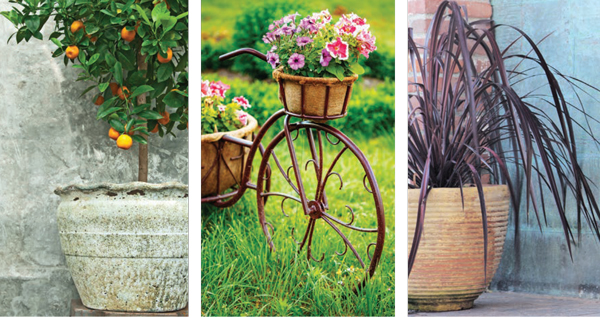
To keep planters looking tidy and green, take time to snip off any brown leaves, deadhead flowers, and yank any stray weeds. If growing herbs, clip them regularly to prevent them from flowering and going to seed. Clipping herbs like basil will make them even bushier and more productive.
Whether you are looking to add colorful flowers to your landscape, or trying to grow your own veggies and herbs, container gardens allow for maximum yield with maximum control and relatively little work. Your containers can be tailored to any decor, while plants can be chosen for beauty, taste or both. You’ll be on your way to creating decorative planters that you can enjoy, and which will also wow neighbors and visitors all season long. ✦
